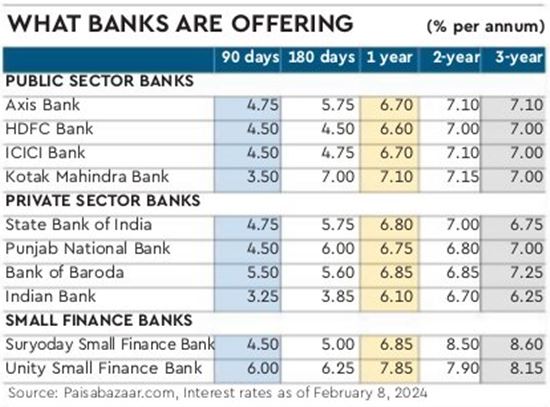While the Reserve Bank of India on Thursday kept the repo rate unchanged for the sixth time in a row, banks may further increase their short-term fixed deposit rates to attract more money, as the loan growth has been robust and liquidity remains tight. Experts say there will be a clamour for short-term deposits, with the one-year rates nudging higher and longer-term rates possibly staying flat.
Banks are increasingly focusing on mobilising retail deposits to meet their credit growth requirements, with several lenders raising rates even for deposits ranging from 200 to 300 days. In fact, four banks ―Axis Bank, Punjab National Bank, HDFC Bank, and IndusInd Bank – have increased their short-term fixed deposit (FD) rates this month.
Speaking to CNBC TV18, State Bank of India managing director Ashwini Kumar Tewari said deposit rates have been going up as the rate of loan growth is higher than the deposit growth for the past several quarters. Higher loan growth and money moving to the equity markets and mutual funds have put a lot of pressure on deposit gathering and deposit rates. “However, this is not so much a function of the monetary policy as it is related to the demand for loans and alternative investment opportunities available to people… Deposit rates can still go up.”
Apart from the repo rates, banks consider several other factors while setting their FD rates. Lenders having high loan-to-deposit ratios may increase their short-term FD rates to attract fresh deposits for funding their credit growth. Tighter liquidity conditions or any increase in the money market rates may push up the rates of short-term fixed deposits.
Given the upward trajectory of short-term deposit rates, employing a laddering strategy in short-term FDs can be particularly advantageous. Adhil Shetty, CEO at Bankbazaar.com, said instead of consolidating all funds into a single FD, diversify by opening multiple FDs with varying short-term tenures. “This enables reinvestment opportunities whenever there’s a chance to secure higher interest rates and maximising returns over time.”
Depositors must note that for a few banks, the interest rates for one-year deposits are higher than those for three and five years. Depositors can open short-term bank FDs to park their short-term surpluses provided the rates offered for such FDs are attractive.

Gaurav Aggarwal, chief product officer, credit products, Paisabazaar, said depositors should compare savings account interest rates offered by small finance banks and some private sector banks, especially those offering interest rates slabs of 5-7%. “Such high-yield savings accounts would offer higher liquidity and flexibility than short-term bank FDs and liquid mutual funds.”

